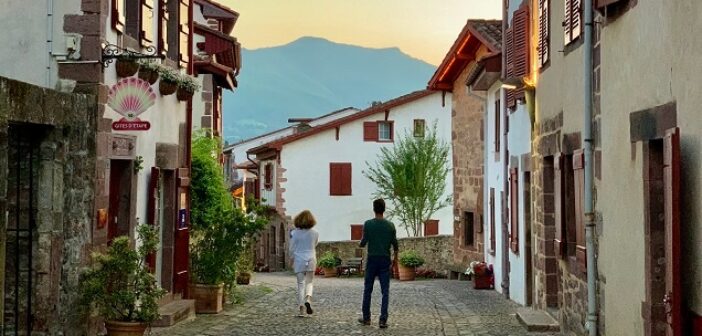Since becoming my new home base at the start of this year, Saint Jean Pied de Port delights me a little more each day. Lying between the Basque Country and the Spanish frontier, it’s the starting-point of the legendary mountain crossing known as the Ports de Cize, which leads through the Pyrénées to the Royal Collegiate Church of Roncevalles. Discover it with me !
A little history
People who don’t know the region might easily make the mistake of writing Saint Jean Pied de Porc (« Saint John Pig Foot »), since the country raises so many of them—the local breed being the pie noir (« black magpie »). Still, the word is not Porcs, but Ports. The town is named¹ for its location at the foot of the ports, a local word meaning passes, crossing a region of the Pyrénées called the Cize². Over the centuries in this mountain country, a settlement became a fort, then a border crossing and commercial center between France and Spain; while the route through the “Ports de Cize” has been successively shepherds’ track, Roman road, invasion route, military road, a trail for pilgrims to Santiago de Compostela, and—today—for hikers as well.
The name in Basque is Donibane Garazi. Don means Saint, Iban is Jean, and Garazi is the Basque name of the Cize (the name Garazi is often used in French as well as Basque). The inhabitants of the town are the Donibandar (or Donibanegaraztar) -in French, the Saint-Jeannais.
The road to Santiago
The old town with its ramparts makes a famous stop on one of the principal pilgrimage ways to Santiago de Compostela³. Here some pilgrims interrupt the journey, resuming their trek to Spain the following year; many others begin here -especially the non-Europeans: Americans, Australians, Canadians, Koreans, New Zealanders, etc. The 25-km stage from here to Roncevalles, part of which follows the Route Napoléon (his road back from Elba), can be a little frightening in its elevation gain (from 181 to 1,400 meters), especially for the first 9 kilometers—not to mention the abrupt descent into Spain that follows. But if you have hiking poles, good shoes, a backpack that’s not too heavy, and plenty of water, it’s completely doable -and breathtakingly beautiful.
Since 1992, when the Pilgrims’ Welcome Center opened in Saint-Jean-Pied-de-Port, the number of walkers has gone from 3,000 a year to more than 61,000 in 2019. Of the 114 nationalities represented, the top 10 are France, Spain, USA, Italy, South Korea, Germany, Britain, Australia, Canada, Ireland.
Walkers’ paradise
Saint Jean is ranked among the Most Beautiful Villages in France, and in season -from Easter to All Saints’ Day- a large number of visitors combs the streets and ramparts of the old town. Houses of typical, traditional Basque architecture display their white facades with red shutters (sometimes green), decorated here and there with half-timbering or sculptured lintels. The weather is rarely very cold or very warm, winters are mild, but it is easy to see where the green hills and luxuriant gardens come from… rain is not a special event in Garazi, it’s part of normal life for the Saint Jeannais.
The Arradoy is an imposing hill which dominates the old town. As far back as the 13th century, builders quarried its superb grès rose with a slight violet tint—which can be seen in the walls of the church of Notre Dame au Bout du Pont, of the ramparts, and of numerous houses.
Hiking trails are all around, each one more spectacular than the last (especially the famous GR 10 and GR 65). Watch out –you’ll have to climb ! There are also numerous excursions to be made by cycling, motorcycle, or car: the valley of the Aldudes, the forest of Iraty, the forest of Orion, etc. Don’t forget to stop at Espelette, Ainhoa, Cambo (where you can visit the home and museum of Edmond Rostand) on your way to Saint Jean de Luz, Biarritz, or Bayonne -all three destinations within 50 km or so of the town.
You can already see that this Bretonne has definitely adopted the village that welcomed her so warmly in the depth of winter. Now I just need to learn Basque -indispensable when one chooses to live in Garazi. And that will be when we go back to school, since I’m signed up for the course… Ikus arte !
Marie-Hélène Cossé
Translated by Pr Andrew Kull
¹Saint Juan del Pie Portus, in honor of its successive patrons St. John the Evangelist and St. John the Baptist.
²The passes called Arnostéguy (1,236 m), Bentarte (1,344 m), Leopeder (1,440 m), and Ibañeta (1,057 m) are considered to be easy crossings of the Pyrénées.
³The town is situated on three Santiago pilgrimage routes which have been running together since Ostabat. From here they continue to Roncevalles, then to Santiago.
Sightseeing : the Church of Notre Dame, most significant Gothic structure in the French Pays Basque; the Porte Sant-Jacques, a UNESCO world heritage site; the Porte d’Espagne; the Citadel and fortifications; the prison known as “des Évêques.”
Strolling and shopping : rue d’Espagne (ham, cheese, local wine Irouléguy , petits cannelés ; bérêts, hand-made espadrilles, Basque table linens) ; walk up to the Citadel, return by the Chemin de Ronde.
Where to eat : Arrambide, Le Chat Perché, Le Relais de la Nive, le Café Ttipia.
Where to stay : Hôtel les Pyrénées, Hôtel Central, Maison d’hôtes Donamaria.

